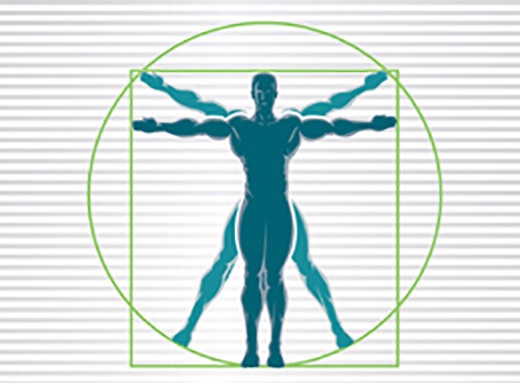Leonardo da Vinci’s globally recognized illustration “Vitruvian Man”, created around 1490 AD, is an inspirational reminder that human bodies are amazingly symmetrical, beautiful and functional. For example, human arm span is the same length as body height, forming a square in his illustration. At the center of a circle, circumscribed by outstretched arms and legs, is the navel. The navel is also located at the “golden ratio” point along the human body. The golden ratio, a measure of symmetry and natural beauty famous among mathematicians and architects (symbolized by the Greek letter phi), can be found throughout the body when analyzing the lengths of related body parts, body dimensions, and facial features. In fact, symmetry and special ratios can be found throughout the natural world, and in the physical laws of nature and the universe. (Learn more about the golden ratio).
The very special ratio of waist circumference to body height (W:Ht ratio), scientifically validated primarily by Dr. Margaret Ashwell, is an important health measure. A healthy waist circumference, measured at the navel, is less than half the body height. Excess unhealthy body fat, which increases risk for heart disease, diabetes, and related health problems, produces a waist to height ratio of 0.5 or higher. A ratio of 0.6 or higher is especially concerning. A ratio of less than 0.4 is also out of balance from being too slender or underweight. Once you measure your waist size and height, you can check your ratio by using this chart.
This “golden” waist to height ratio applies to all people. This is what makes it so beautiful and attractive, both philosophically and medically. No matter your age, race, gender, build, muscularity, or just about any other factor—the healthy range holds true. This is also a great advantage over using the Body Mass Index (BMI) to estimate excess body fat. BMI measurements compare the body weight to the body height, a reasonable but notoriously imperfect way of indicating obesity, overweight, or normal body weight. For example, some individuals with a BMI of 25.0 (kg per sq. meter) have excess unhealthy body fat, while others do not—especially lean athletes with a muscular build, and taller healthy men. However, accounting for the waist size will distinguish between healthy and unhealthy (excess) body fat levels better than body weight or BMI because it matters where the body fat is carried.
Scientific studies1-2 document the superiority of the waist-to-height ratio over body mass index (or waist size alone) for predicting heart disease, type 2 diabetes, and related risk factors, as well as longevity. Therefore, measuring the waist size is a highly recommended step. Doing so might be a little bit more effort than measuring the weight, but it adds important health information about heart disease risk and longevity not captured by the scale alone.
The Boston Heart Lifestyle Program, which provides patients with scientifically designed, individualized dietary and exercise advice and support, uses the waist-to-height ratio rather than BMI. A proven way to get closer to the healthy “golden” waist-to-height ratio, is to embrace the power of lifestyle change, get a Life Plan, and work with our registered dietitian coaches via telephone to minimize your risk and maximize your health.
The time to act is now! As Leonardo da Vinci himself exclaimed: “I have been impressed with the urgency of doing. Knowing is not enough; we must apply. Being willing is not enough; we must do.”
References
